Yile Wang
Ranked Voting based Self-Consistency of Large Language Models
May 16, 2025Abstract:Majority voting is considered an effective method to enhance chain-of-thought reasoning, as it selects the answer with the highest "self-consistency" among different reasoning paths (Wang et al., 2023). However, previous chain-of-thought reasoning methods typically generate only a single answer in each trial, thereby ignoring the possibility of other potential answers. As a result, these alternative answers are often overlooked in subsequent voting processes. In this work, we propose to generate ranked answers in each reasoning process and conduct ranked voting among multiple ranked answers from different responses, thereby making the overall self-consistency more reliable. Specifically, we use three ranked voting methods: Instant-runoff voting, Borda count voting, and mean reciprocal rank voting. We validate our methods on six datasets, including three multiple-choice and three open-ended question-answering tasks, using both advanced open-source and closed-source large language models. Extensive experimental results indicate that our proposed method outperforms the baselines, showcasing the potential of leveraging the information of ranked answers and using ranked voting to improve reasoning performance. The code is available at https://github.com/szu-tera/RankedVotingSC.
LDIR: Low-Dimensional Dense and Interpretable Text Embeddings with Relative Representations
May 15, 2025Abstract:Semantic text representation is a fundamental task in the field of natural language processing. Existing text embedding (e.g., SimCSE and LLM2Vec) have demonstrated excellent performance, but the values of each dimension are difficult to trace and interpret. Bag-of-words, as classic sparse interpretable embeddings, suffers from poor performance. Recently, Benara et al. (2024) propose interpretable text embeddings using large language models, which forms "0/1" embeddings based on responses to a series of questions. These interpretable text embeddings are typically high-dimensional (larger than 10,000). In this work, we propose Low-dimensional (lower than 500) Dense and Interpretable text embeddings with Relative representations (LDIR). The numerical values of its dimensions indicate semantic relatedness to different anchor texts through farthest point sampling, offering both semantic representation as well as a certain level of traceability and interpretability. We validate LDIR on multiple semantic textual similarity, retrieval, and clustering tasks. Extensive experimental results show that LDIR performs close to the black-box baseline models and outperforms the interpretable embeddings baselines with much fewer dimensions. Code is available at https://github.com/szu-tera/LDIR.
Perspective Transition of Large Language Models for Solving Subjective Tasks
Jan 16, 2025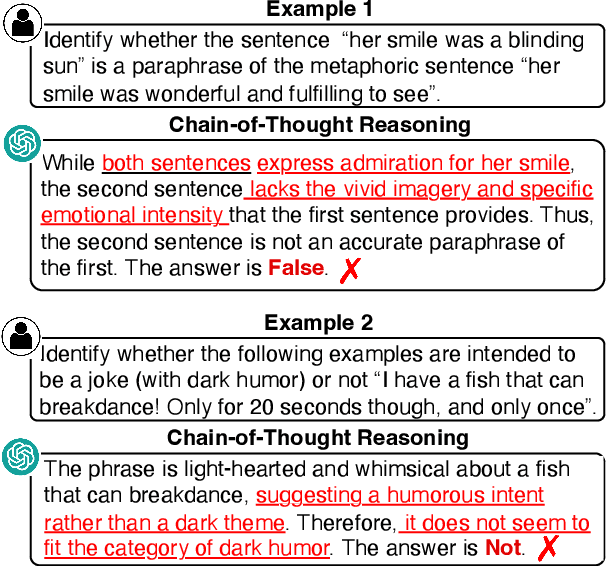
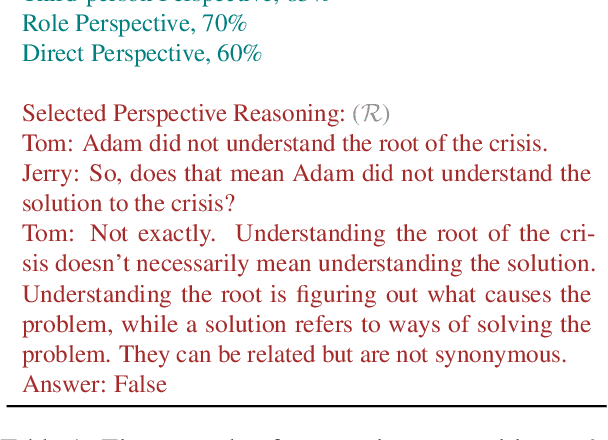
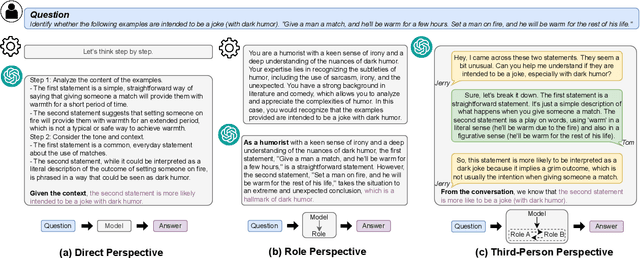
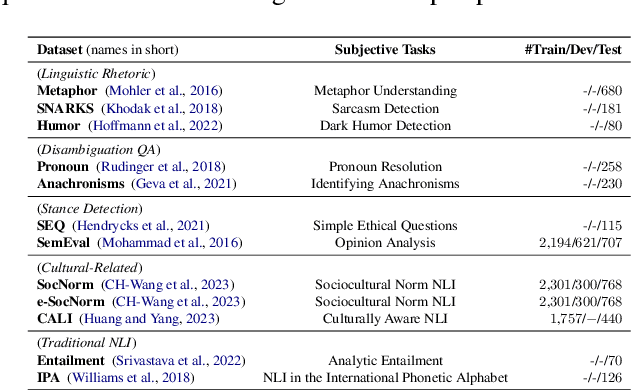
Abstract:Large language models (LLMs) have revolutionized the field of natural language processing, enabling remarkable progress in various tasks. Different from objective tasks such as commonsense reasoning and arithmetic question-answering, the performance of LLMs on subjective tasks is still limited, where the perspective on the specific problem plays crucial roles for better interpreting the context and giving proper response. For example, in certain scenarios, LLMs may perform better when answering from an expert role perspective, potentially eliciting their relevant domain knowledge. In contrast, in some scenarios, LLMs may provide more accurate responses when answering from a third-person standpoint, enabling a more comprehensive understanding of the problem and potentially mitigating inherent biases. In this paper, we propose Reasoning through Perspective Transition (RPT), a method based on in-context learning that enables LLMs to dynamically select among direct, role, and third-person perspectives for the best way to solve corresponding subjective problem. Through extensive experiments on totally 12 subjective tasks by using both closed-source and open-source LLMs including GPT-4, GPT-3.5, Llama-3, and Qwen-2, our method outperforms widely used single fixed perspective based methods such as chain-of-thought prompting and expert prompting, highlights the intricate ways that LLMs can adapt their perspectives to provide nuanced and contextually appropriate responses for different problems.
Property Enhanced Instruction Tuning for Multi-task Molecule Generation with Large Language Models
Dec 24, 2024Abstract:Large language models (LLMs) are widely applied in various natural language processing tasks such as question answering and machine translation. However, due to the lack of labeled data and the difficulty of manual annotation for biochemical properties, the performance for molecule generation tasks is still limited, especially for tasks involving multi-properties constraints. In this work, we present a two-step framework PEIT (Property Enhanced Instruction Tuning) to improve LLMs for molecular-related tasks. In the first step, we use textual descriptions, SMILES, and biochemical properties as multimodal inputs to pre-train a model called PEIT-GEN, by aligning multi-modal representations to synthesize instruction data. In the second step, we fine-tune existing open-source LLMs with the synthesized data, the resulting PEIT-LLM can handle molecule captioning, text-based molecule generation, molecular property prediction, and our newly proposed multi-constraint molecule generation tasks. Experimental results show that our pre-trained PEIT-GEN outperforms MolT5 and BioT5 in molecule captioning, demonstrating modalities align well between textual descriptions, structures, and biochemical properties. Furthermore, PEIT-LLM shows promising improvements in multi-task molecule generation, proving the scalability of the PEIT framework for various molecular tasks. We release the code, constructed instruction data, and model checkpoints in https://github.com/chenlong164/PEIT.
Teaching CORnet Human fMRI Representations for Enhanced Model-Brain Alignment
Jul 15, 2024Abstract:Deep convolutional neural networks (DCNNs) have demonstrated excellent performance in object recognition and have been found to share some similarities with brain visual processing. However, the substantial gap between DCNNs and human visual perception still exists. Functional magnetic resonance imaging (fMRI) as a widely used technique in cognitive neuroscience can record neural activation in the human visual cortex during the process of visual perception. Can we teach DCNNs human fMRI signals to achieve a more brain-like model? To answer this question, this study proposed ReAlnet-fMRI, a model based on the SOTA vision model CORnet but optimized using human fMRI data through a multi-layer encoding-based alignment framework. This framework has been shown to effectively enable the model to learn human brain representations. The fMRI-optimized ReAlnet-fMRI exhibited higher similarity to the human brain than both CORnet and the control model in within-and across-subject as well as within- and across-modality model-brain (fMRI and EEG) alignment evaluations. Additionally, we conducted an in-depth analyses to investigate how the internal representations of ReAlnet-fMRI differ from CORnet in encoding various object dimensions. These findings provide the possibility of enhancing the brain-likeness of visual models by integrating human neural data, helping to bridge the gap between computer vision and visual neuroscience.
Reasoning in Conversation: Solving Subjective Tasks through Dialogue Simulation for Large Language Models
Feb 27, 2024



Abstract:Large Language Models (LLMs) have achieved remarkable performance in objective tasks such as open-domain question answering and mathematical reasoning, which can often be solved through recalling learned factual knowledge or chain-of-thought style reasoning. However, we find that the performance of LLMs in subjective tasks is still unsatisfactory, such as metaphor recognition, dark humor detection, etc. Compared to objective tasks, subjective tasks focus more on interpretation or emotional response rather than a universally accepted reasoning pathway. Based on the characteristics of the tasks and the strong dialogue-generation capabilities of LLMs, we propose RiC (Reasoning in Conversation), a method that focuses on solving subjective tasks through dialogue simulation. The motivation of RiC is to mine useful contextual information by simulating dialogues instead of supplying chain-of-thought style rationales, thereby offering potential useful knowledge behind dialogues for giving the final answers. We evaluate both API-based and open-source LLMs including GPT-4, ChatGPT, and OpenChat across twelve tasks. Experimental results show that RiC can yield significant improvement compared with various baselines.
DEEM: Dynamic Experienced Expert Modeling for Stance Detection
Feb 23, 2024Abstract:Recent work has made a preliminary attempt to use large language models (LLMs) to solve the stance detection task, showing promising results. However, considering that stance detection usually requires detailed background knowledge, the vanilla reasoning method may neglect the domain knowledge to make a professional and accurate analysis. Thus, there is still room for improvement of LLMs reasoning, especially in leveraging the generation capability of LLMs to simulate specific experts (i.e., multi-agents) to detect the stance. In this paper, different from existing multi-agent works that require detailed descriptions and use fixed experts, we propose a Dynamic Experienced Expert Modeling (DEEM) method which can leverage the generated experienced experts and let LLMs reason in a semi-parametric way, making the experts more generalizable and reliable. Experimental results demonstrate that DEEM consistently achieves the best results on three standard benchmarks, outperforms methods with self-consistency reasoning, and reduces the bias of LLMs.
Enhancing Multilingual Capabilities of Large Language Models through Self-Distillation from Resource-Rich Languages
Feb 19, 2024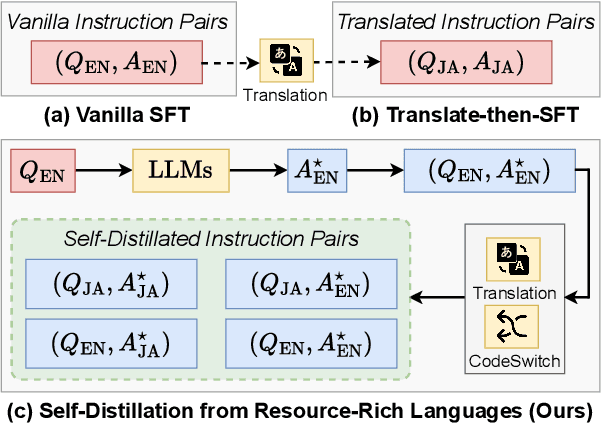


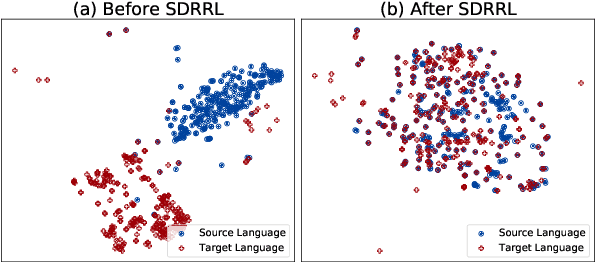
Abstract:While large language models (LLMs) have been pre-trained on multilingual corpora, their performance still lags behind in most languages compared to a few resource-rich languages. One common approach to mitigate this issue is to translate training data from resource-rich languages into other languages and then continue training. However, using the data obtained solely relying on translation while ignoring the original capabilities of LLMs across languages is not always effective, which we show will limit the performance of cross-lingual knowledge transfer. In this work, we propose SDRRL, a method based on Self-Distillation from Resource-Rich Languages that effectively improve multilingual performance by leveraging the internal capabilities of LLMs on resource-rich languages. We evaluate on different LLMs (LLaMA-2 and SeaLLM) and source languages across various comprehension and generation tasks, experimental results demonstrate that SDRRL can significantly enhance multilingual capabilities while minimizing the impact on original performance in resource-rich languages.
Towards Unified Alignment Between Agents, Humans, and Environment
Feb 14, 2024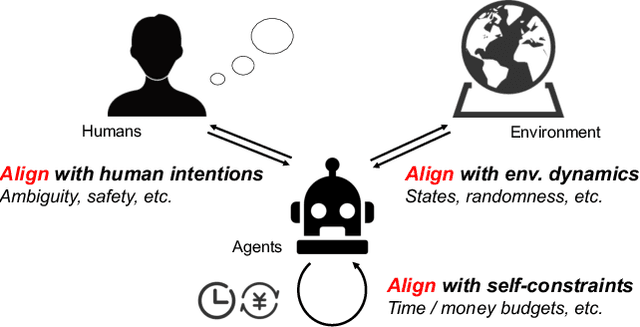
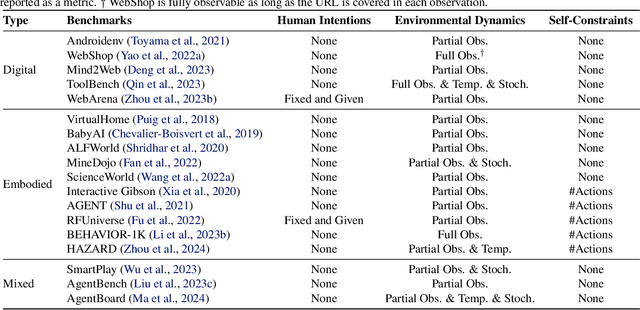
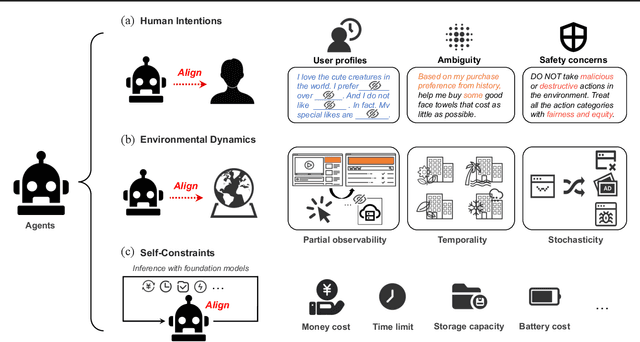

Abstract:The rapid progress of foundation models has led to the prosperity of autonomous agents, which leverage the universal capabilities of foundation models to conduct reasoning, decision-making, and environmental interaction. However, the efficacy of agents remains limited when operating in intricate, realistic environments. In this work, we introduce the principles of $\mathbf{U}$nified $\mathbf{A}$lignment for $\mathbf{A}$gents ($\mathbf{UA}^2$), which advocate for the simultaneous alignment of agents with human intentions, environmental dynamics, and self-constraints such as the limitation of monetary budgets. From the perspective of $\mathbf{UA}^2$, we review the current agent research and highlight the neglected factors in existing agent benchmarks and method candidates. We also conduct proof-of-concept studies by introducing realistic features to WebShop, including user profiles to demonstrate intentions, personalized reranking for complex environmental dynamics, and runtime cost statistics to reflect self-constraints. We then follow the principles of $\mathbf{UA}^2$ to propose an initial design of our agent, and benchmark its performance with several candidate baselines in the retrofitted WebShop. The extensive experimental results further prove the importance of the principles of $\mathbf{UA}^2$. Our research sheds light on the next steps of autonomous agent research with improved general problem-solving abilities.
ReAlnet: Achieving More Human Brain-Like Vision via Human Neural Representational Alignment
Jan 30, 2024Abstract:Despite the remarkable strides made in artificial intelligence, current object recognition models still lag behind in emulating the mechanism of visual information processing in human brains. Recent studies have highlighted the potential of using neural data to mimic brain processing; however, these often reply on invasive neural recordings from non-human subjects, leaving a critical gap in our understanding of human visual perception and the development of more human brain-like vision models. Addressing this gap, we present, for the first time, "Re(presentational)Al(ignment)net", a vision model aligned with human brain activity based on non-invasive EEG recordings, demonstrating a significantly higher similarity to human brain representations. Our innovative image-to-brain multi-layer encoding alignment framework not only optimizes multiple layers of the model, marking a substantial leap in neural alignment, but also enables the model to efficiently learn and mimic human brain's visual representational patterns across object categories and different neural data modalities. Furthermore, we discover that alignment with human brain representations improves the model's adversarial robustness. Our findings suggest that ReAlnet sets a new precedent in the field, bridging the gap between artificial and human vision, and paving the way for more brain-like artificial intelligence systems.
 Add to Chrome
Add to Chrome Add to Firefox
Add to Firefox Add to Edge
Add to Edge